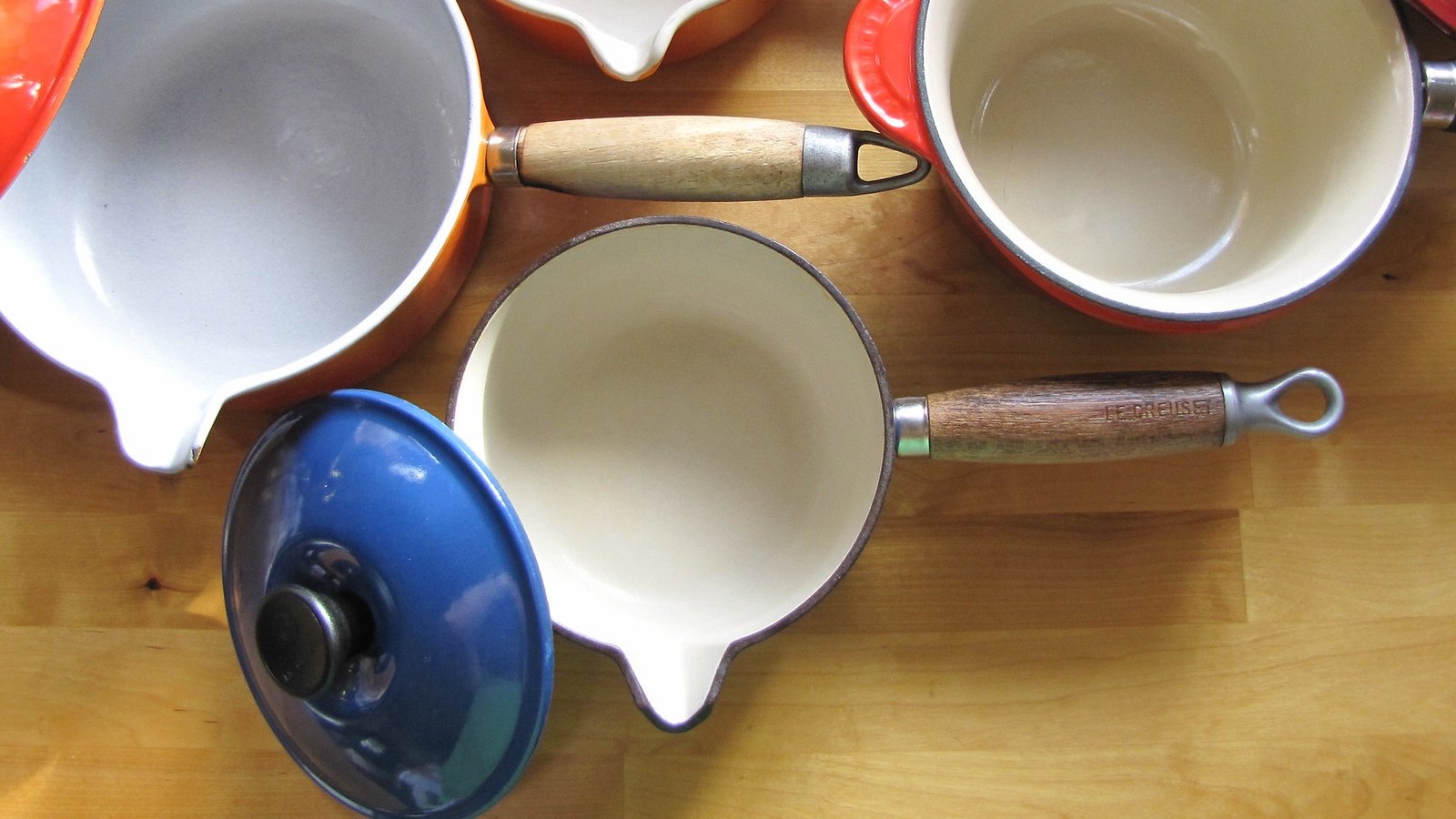How Does Ceramic Cookware Differ From Enamel Cookware?
In addition to having non-stick properties, enamel cookware is durable, attractive, and heat-retentive. Ceramic cookware, on the other hand, is non-reactive to acidic foods and promotes healthy cooking.
But what is the real difference between these two terms?
Ceramic is a dense, brittle, heat- and corrosion-resistant solid made by firing an inorganic, non-metallic material at high temperatures. Porcelain enamel or vitreous enamel is a thin layer of powdered glass fused at high temperatures onto a metal’s surface.
The word ceramic derives from the Greek word for pottery. Clay-based traditional ceramics include earthenware, stoneware, and porcelain. The composition of the clay, the firing temperature, and the type of additives distinguish them from one another.
In today’s world, ceramics refers to a wide variety of materials, including advanced ceramics, glass, and some cement systems.
Advanced ceramics are not clay-based; instead, they are either oxides or non-oxides, or a combination of both.
How Does Enamel Coating Affect A Metal Surface?
Vitreous enamel or porcelain enamel melts, flows, and hardens into a smooth durable coating. It ensures a chemical and scratch-resistant surface for healthy cooking. The non-porous vitreous enamel layer functions as a superior heat conductor, resulting in faster and more efficient cooking.
In this video, you will get a sense of what vitreous enameling is like:
To get a good understanding of the process of making non-stick enamel cookware, watch this video:
What Is Enamel Cookware?
In general, they are most often cast iron with an enamel coating to create a non-porous finish that protects the core material. Aluminum and steel are also possible metal bases.
[amazon box=”B07SJVKH11″]
A non-stick cooking surface allows food to brown without sticking to the pan.
Can Enamel-Coated Cookware Be Toxic?
It is healthy to cook with enamel cookware since the food won’t react with the metal. Therefore, you can cook almost anything in them, including tomatoes and other acidic foods. The enamel coating is in glass form so it is easy to clean.
You can heat them to high temperatures, making them a popular choice for sears and braises. As they conduct and hold heat well, they maintain an even temperature throughout the whole pot.
Which Types Of Ceramic Cookware Are Available?
Ceramic cookware comes in two types. The first type is 100% ceramic cookware made from clay, minerals, and quartz sand, whereas the second comes with a nonstick ceramic coating.
Ceramic cookware is versatile, so you can use it on almost all stovetops. They feature fast heating and even heat distribution across the entire cooking surface.
[amazon box=”B09WQM3SK7″]
Regardless of whether your food is in the center of the pan or not, you can ensure that it will cook evenly.
What Is Ceramic Enamel Cookware Coating Made Of?
Silica and other inorganic chemicals combine to form this nonstick sol-gel coating. It prevents food from sticking by using a mineral applied in a gel solution that is non-toxic rather than PTFE. The ceramic coating is free of PFOA, a toxic chemical you find in traditional non-stick coatings.
How Healthy Is Enamel For Cooking?
FDA’s center for food safety and applied nutrition considers enamel-coated iron cookware to be safer.
In addition to being easier to clean, the inner coating also prevents iron from leaching into food, clinging to it, and reacting with acidic substances in the food.
Due to the neutral nature of enamel coating, you can prepare a variety of foods with it. It is also possible to keep food fresh longer in them. Due to its non-rusting nature, it minimizes health risks.
Is Ceramic Enamel The Same As Porcelain Enamel?
In general porcelain enamel is also known as ceramic enamel. Porcelain is a ceramic material made from heating substances such as white kaolin, quartz, feldspars, steatite, and other minerals.
Porcelain is one type of ceramic, but not all ceramic is porcelain. In this guide, you can learn more about porcelain and ceramic: What is the difference between ceramics and porcelain? (Complete guide)
As you cook, the inert porcelain enamel cookware does not leach chemicals or metals into your food.
Having a high heat transfer capacity, they are well suited for many different recipes. When cleaning the device, you need to pay attention to prevent it from chipping.
But there is a slight difference between the composition of ceramic and porcelain since ceramic is more porous than porcelain.
A porcelain enamel cookware has a built-in coating for safe cooking. It is also denser and more durable than ceramic cookware.
How Safe Is Ceramic Enamel Cookware?
Ceramic enamel is also non-toxic like porcelain and provides a good surface for healthy cooking. Pure ceramic cookware can withstand high temperatures with great safety in the oven and it is fine for baking and roasting.
Ceramic cookware is safe because its chemicals won’t break down at high temperatures. This device allows you to prepare a variety of recipes both on the stovetop and in the oven. It is a safer non-stick alternative to Teflon. It does not produce any toxic fumes at high temperatures.

How Efficient Is Ceramic Cookware?
It only requires a touch of oil or butter to keep food from sticking to the smooth ceramic coating. This allows you to sauté a variety of foods instead of boiling or steaming them, which can reduce their nutritional value.
The efficient heat transfer of ceramic cookware means that you can cook with little power. As it is non-reactive and does not contain chemical additives, there is nothing to leach into your food.
Does Enamel-Coated Cookware Pose A Health Issue?
Enamel cookware is also a healthier alternative to Teflon which may release toxic gasses under high heat.
Over time Teflon’s coating can flake off due to wear and tear, resulting in health issues. Conversely, enamel-coated cookware can last decades if you handle it with proper care.
The enamel coating on your cookware prevents leaching any chemicals from its core of metal into your food and reacting with acidic ingredients within it.
Does Enamel Cookware Go In The Oven?
The heavy steel or porcelain construction of enamel cookware allows it to withstand high temperatures.
As a result, you can use it on the stove or open flame. It is also safe to use enamelware in the oven up to 500°F, although you may need to follow the user manual.







